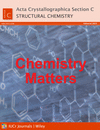issue contents
February 2023 issue

Cover illustration: The crystal structure of the pyridine analog of the selenium pharmaceutical ebselen is characterized by one-dimensional N—Se chalcogen-bonded chains where the pyridine N atom is the chalcogen-bond acceptor. Charge density analysis using high-resolution Mo Kα X-radiation and subsequent multipole refinement reveals a clear region of positive electrostatic potential at the antipode to the Se—N bond of the isoselenazole moiety. In the N-methylated iodide and tosylate salts, the iodide/tosylate counter-ions are strongly chalcogen bonded to the Se atom. See Xu, Fellowes & White [Acta Cryst. (2023), C79, 43–51].
editorial
 access
accessHalogen, chalcogen, pnictogen and tetrel bonds


 access
access



 access
accessresearch papers




addenda and errata
 access
access
 journal menu
journal menu
























